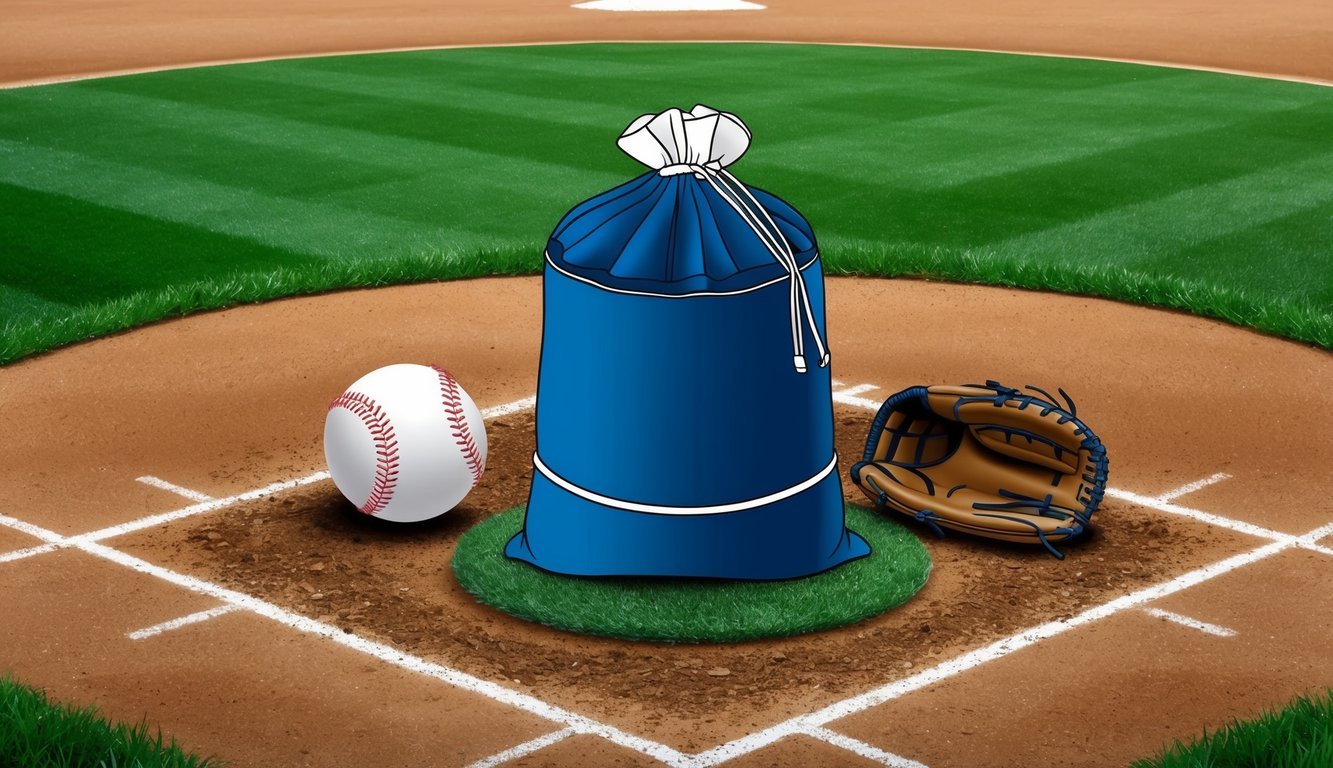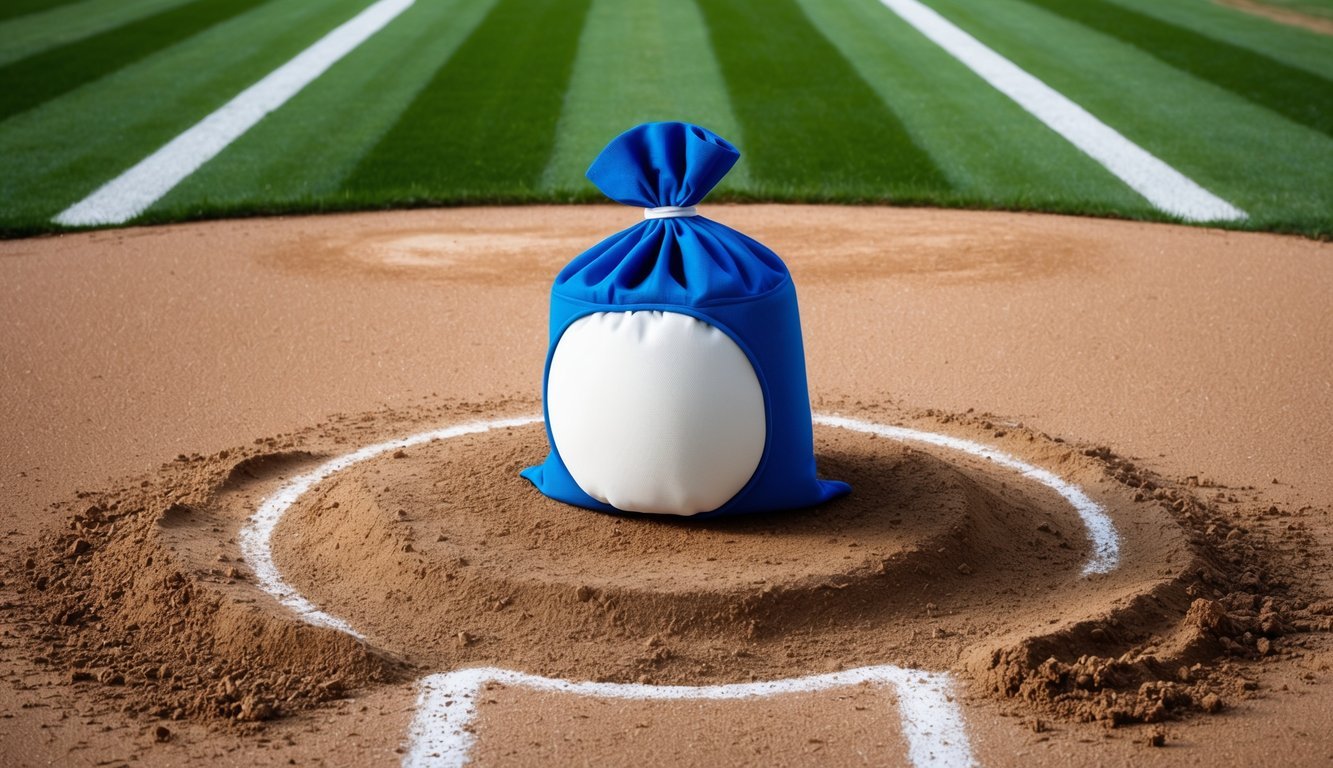Baseball pitchers have long relied on a small but crucial tool to enhance their performance on the mound.
The rosin bag, a simple pouch filled with sticky powder, has been a staple of the game for decades. Rosin bags help pitchers improve their grip on the baseball, allowing for better control and potentially increased spin rates on pitches.
Derived from pine tree sap, rosin is the only sticky substance officially permitted by Major League Baseball.
Pitchers can find a rosin bag on the back of the mound during games, ready to combat sweat and moisture that might otherwise interfere with their grip.
This legal aid has become an integral part of pitching strategy, with many hurlers developing specific routines for using the rosin bag between pitches.
The history of rosin in baseball dates back to the early 20th century.
As the game evolved, so did the need for pitchers to maintain consistent control over their throws.
The introduction of rosin bags provided a solution that balanced fairness with performance enhancement.
Today, these unassuming pouches remain a familiar sight on baseball diamonds across America, from Little League fields to major league stadiums.
Understanding Rosin and Its Uses in Baseball
Rosin plays a crucial role in baseball, enhancing grip and performance for players on the field.
This naturally-derived substance has become an essential tool, particularly for pitchers seeking better control over their throws.
The Essentials of Rosin
Rosin is a solid form of resin obtained from pine trees.
It’s typically processed into a fine powder and packed into small canvas bags for use in baseball.
The substance has a sticky quality when exposed to friction, making it ideal for improving grip.
Rosin bags contain a mixture of pine rosin and magnesium carbonate.
This combination helps absorb sweat and provides tackiness without being overly sticky.
Players often apply rosin to their hands before pitching or batting to enhance their hold on the ball or bat.
Rosin Bag’s Role for Pitchers
Pitchers rely heavily on rosin bags to maintain consistent performance throughout a game.
The bag is usually placed on the backside of the pitcher’s mound for easy access.
Pitchers often take a moment to apply rosin to their hands to achieve the ideal grip on the ball, ensuring better control over their pitches.
In addition to the rosin bag, some players have reported that using a small bucket of rice for pitchers helps improve their grip strength and finger dexterity, further enhancing their performance on the mound.
The combination of these tools allows pitchers to feel more confident as they face opposing batters.
By applying rosin to their fingers and palm, pitchers can:
- Reduce slippage, especially in hot or humid conditions
- Improve control over pitch movement and velocity
- Increase spin rate on certain pitches
Rosin provides a legal way for pitchers to enhance their grip without resorting to banned substances.
It’s an accepted part of the game that helps level the playing field while ensuring fair play.
Other Applications of Rosin in Sports
While rosin is most commonly associated with baseball, its grip-enhancing properties make it valuable in other sports and activities:
- Gymnastics: Athletes use rosin on their hands and feet for better grip on apparatus
- Rock climbing: Climbers apply rosin to their hands to improve friction on holds
- Weightlifting: Lifters use rosin to maintain a secure grip on barbells and dumbbells
In these applications, rosin serves a similar purpose to its use in baseball – providing athletes with enhanced control and safety during their performances.
Regulations and Legal Aspects of Rosin Use
Rosin plays a unique role in baseball, being one of the few substances explicitly allowed for pitchers to use.
MLB has specific rules governing its use, while maintaining strict prohibitions on other grip-enhancing materials.
MLB Rules on Rosin Usage
Pitchers can legally use rosin during games.
A rosin bag is placed behind the mound for easy access.
Pitchers may apply rosin to their bare hands but not directly to the baseball.
Umpires monitor rosin use to ensure compliance with regulations.
The rules allow pitchers to combine rosin with sweat or water from the playing field.
This mixture helps improve grip without altering the ball’s movement.
Batters can also use rosin on their hands for better bat control.
Banned Substances and Rosin
While rosin is legal, MLB bans many other substances.
Pine tar, pelican bat wax, and sunscreen are prohibited for pitchers.
These substances can significantly alter ball movement and give unfair advantages.
In recent years, MLB has cracked down on “sticky stuff” like Spider Tack.
Umpires now conduct regular checks of pitchers during games.
Violations can result in ejections and suspensions.
Rosin remains the primary legal option for pitchers to manage grip.
Its widespread acceptance stems from its mild effects compared to more potent foreign substances.
Rosin’s Impact on Pitching and Performance

Rosin plays a crucial role in enhancing a pitcher’s grip and control, leading to improved performance on the mound.
Its effects can be observed in various aspects of pitching, from increased spin rates to better overall statistics.
How Rosin Enhances Pitching
Rosin provides pitchers with a tackier grip on the baseball, allowing for more precise control.
This improved grip enables pitchers to execute their pitches with greater accuracy and consistency.
By reducing the effects of sweat and moisture, rosin helps pitchers maintain their grip even in challenging weather conditions.
The enhanced grip also allows pitchers to apply more force and spin to the ball without fear of it slipping from their fingers.
This can result in sharper breaking pitches and more movement on fastballs.
Many pitchers report feeling more confident in their abilities when using rosin, knowing they have a reliable grip on the ball.
This confidence can translate into better overall performance and decision-making on the mound.
Spin Rate and Rosin
Rosin’s impact on spin rate is significant in modern baseball.
Higher spin rates generally lead to more movement on pitches, making them harder for batters to hit.
Fastballs with higher spin rates appear to “rise” more, while breaking balls with increased spin have sharper, more dramatic movement.
Rosin allows pitchers to grip the ball more firmly, potentially increasing the spin rate on their pitches.
Some studies have shown that pitchers using rosin can see an increase in spin rate of up to 200-300 RPM on certain pitches.
This boost can make a noticeable difference in pitch effectiveness and batter reaction time.
Performance Trends and Statistical Insights
The use of rosin has been linked to improvements in several key pitching statistics.
Pitchers often see a decrease in their ERA (Earned Run Average) when consistently using rosin to enhance their grip.
Control metrics, such as walks per nine innings, tend to improve with rosin use.
Pitchers report better command of the strike zone and fewer wild pitches.
Strikeout rates may increase as pitchers can throw their best stuff with more confidence and precision.
This is particularly evident in breaking pitches, which benefit greatly from the improved grip.
Here’s a quick look at potential statistical improvements:
- ERA: Decrease of 0.25-0.50 points
- K/9 (Strikeouts per 9 innings): Increase of 0.5-1.0
- BB/9 (Walks per 9 innings): Decrease of 0.2-0.4
These trends highlight the positive impact rosin can have on a pitcher’s overall performance and effectiveness on the mound.
The Composition and Maintenance of Rosin Bags

Rosin bags play a crucial role in baseball, helping pitchers maintain a firm grip on the ball.
These small but mighty tools require specific ingredients and proper care to perform effectively on the field.
Ingredients of a Quality Rosin Bag
A high-quality rosin bag typically contains a mixture of powdered pine resin and other grip-enhancing substances.
The main component, pine resin, is derived from fir trees and other conifers.
Some manufacturers add magnesium carbonate, a chalk-like substance, to improve the bag’s moisture-absorbing properties.
The outer casing of a rosin bag is usually made of durable canvas material.
This sturdy fabric allows the powdered contents to seep through when applied to a player’s hands while preventing excessive spillage.
Many professional-grade rosin bags boast “100% Genuine Rock Rosin” as their primary ingredient.
Some brands may include small amounts of powdered pine tar to further enhance grip in humid conditions.
Care Tips for Rosin Bags
Proper maintenance of rosin bags ensures their longevity and effectiveness.
After each use, gently pat the bag to redistribute the contents evenly.
Store the bag in a cool, dry place away from direct sunlight to prevent clumping of the powder.
Avoid exposing rosin bags to moisture, as this can cause the contents to harden.
If the bag becomes damp, allow it to air dry completely before using it again.
Replace rosin bags regularly, especially if they show signs of wear or reduced effectiveness.
Most professional teams swap out their rosin bags every few games to maintain optimal performance.
When traveling with rosin bags, consider using a sealed container to prevent accidental spills in equipment bags.
This also helps protect the powder from humidity during transport.
The Role of Rosin Bags in Baseball Culture and History

Rosin bags have been an integral part of baseball for over a century, leaving their mark on the game’s culture and history.
These unassuming pouches have played a crucial role in shaping pitching techniques and strategies.
Historical Significance of Rosin in Baseball
Rosin bags first appeared on baseball fields in the early 1900s.
Pitchers quickly embraced them as a legal way to improve their grip on the ball.
The bags became a common sight on pitcher’s mounds across all levels of the sport.
In the Minor Leagues, rosin bags helped young pitchers hone their skills.
Major League Baseball officially sanctioned their use in 1925, cementing their place in the game.
Rosin bags found a permanent home near the pitcher’s mound and in the on-deck circle.
They became as much a part of baseball’s visual landscape as the bat and glove.
Famous Moments and Players
Many legendary pitchers have relied on rosin bags throughout their careers.
The New York Yankees’ Whitey Ford was known for his expert use of rosin to enhance his curveball.
In 2022, Max Scherzer of the New York Mets made headlines when umpires repeatedly checked his hands for excessive rosin use.
This incident sparked debates about pitching regulations.
Some pitchers developed unique routines with rosin bags.
For instance, Greg Maddux of the Atlanta Braves had a distinctive habit of touching the bag before each pitch, making it part of his rhythm on the mound.
Rosin bags have even played roles in dramatic moments.
In a 1986 World Series game, the New York Mets’ Jesse Orosco celebratorily threw his rosin bag in the air after securing the final out.
